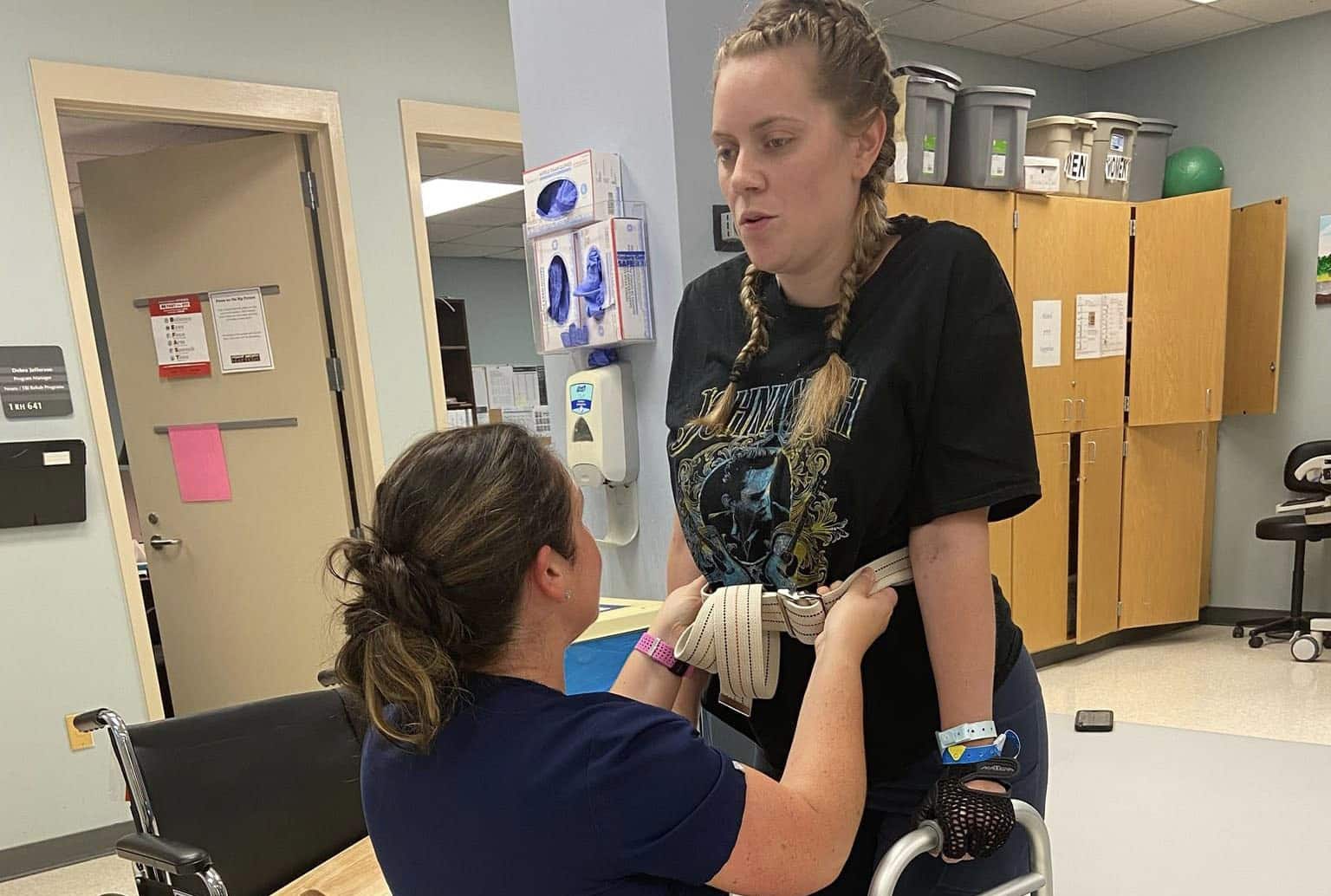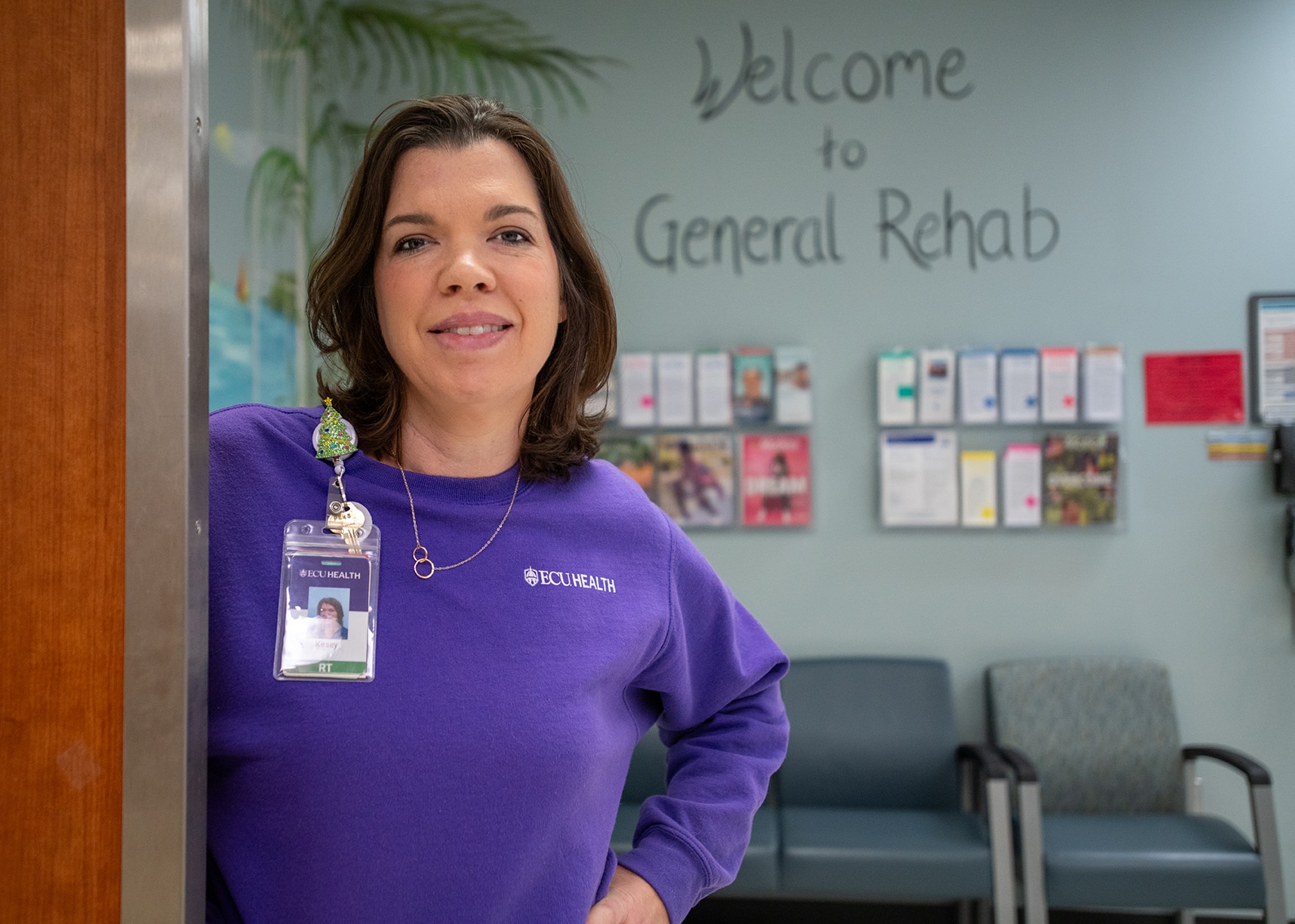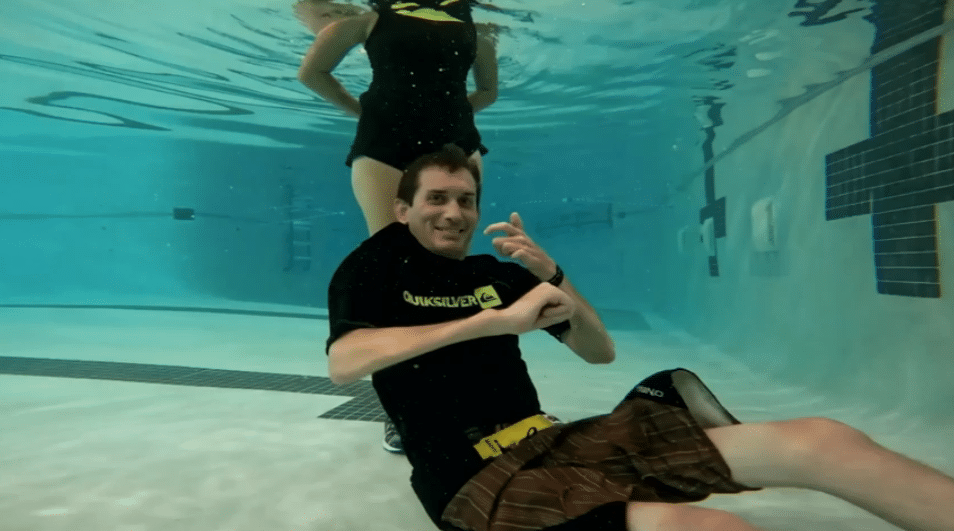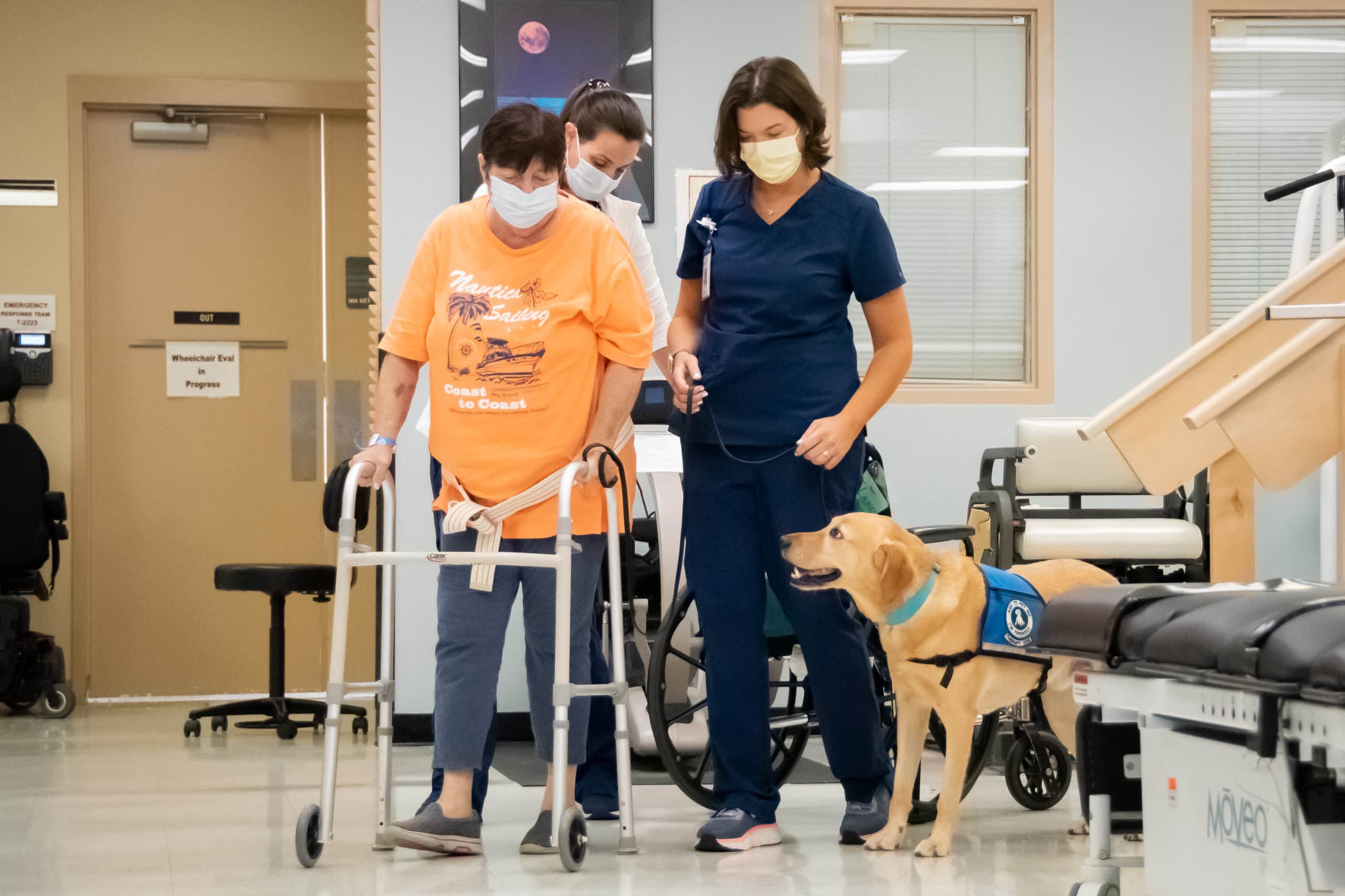ECU Health Rehabilitation will host its 13th annual Run, Walk and Roll to Independence event on Saturday, Nov. 9, bringing together former patients, their families and community members of all physical abilities. Participants can choose between a 5K or 1K course, with proceeds supporting vital rehabilitation programs. This year’s event carries special significance for Brittany Parker, who is returning not just as a participant but as a symbol of resilience after her own journey through rehabilitation.
In August 2023, Parker was navigating her first week back at work after maternity leave when she began experiencing unusual symptoms. What started as a mild tingling sensation in her fingers and toes on Monday gradually escalated. By the end of the week, Parker felt increasingly weak and fatigued, and by Friday, she could no longer lift her three-month-old baby.
Initially attributing her symptoms to exhaustion or perhaps low iron, Parker realized something was seriously wrong when she struggled to stand and walk. After falling at home, she and her family made the decision to go to the emergency room.
At the hospital, doctors quickly identified the underlying cause of her symptoms: Guillain-Barre syndrome (GBS), a rare but serious autoimmune disorder in which the body’s immune system mistakenly attacks the peripheral nerves. The condition can lead to muscle weakness, paralysis, and in severe cases, respiratory failure.
“By the time I reached the hospital, I could no longer lift my arms or legs,” Parker said.
At ECU Health Medical Center, she was diagnosed early, and treatment began right away, which helped stop the progression of the disease.
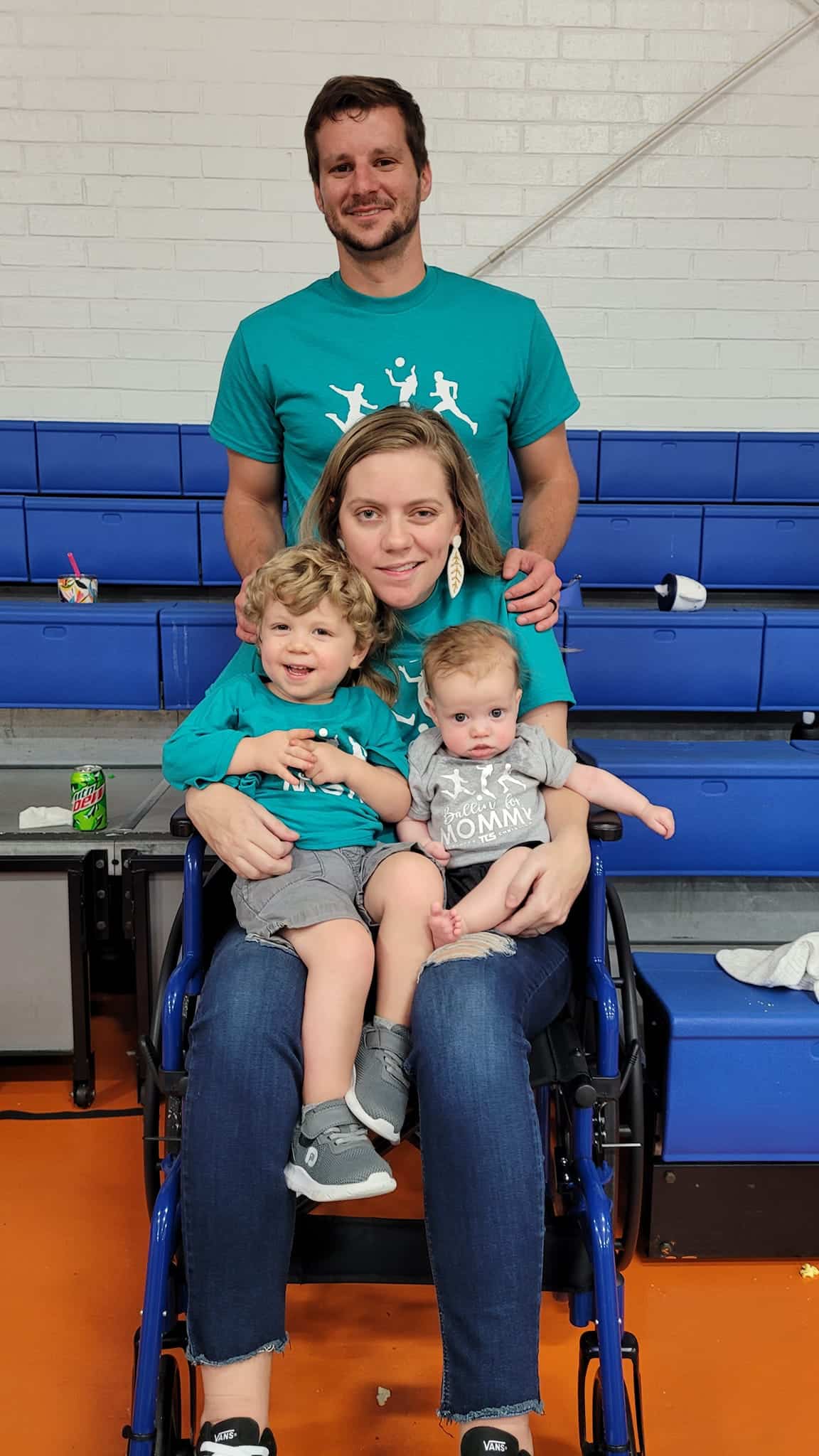
While her physical symptoms improved, Parker faced a new challenge: learning how to do everything again. After two weeks in the hospital, she was transferred to ECU Health’s rehabilitation center, where she began the long road to recovery.
“I had to relearn how to walk and even how to swallow,” said Parker.
The rehabilitation process was difficult, but Parker found strength in her care team.
“Everyone I worked with was amazing, from physical therapists to speech therapists. Melissa, my physical therapist, was so positive and encouraging. She celebrated every small victory with me, which made me want to push harder,” Parker said.
For four weeks, Parker worked tirelessly in rehab, gradually regaining the strength to walk, eat and move on her own again. Her recovery exceeded expectations, and she was able to return home earlier than anticipated.
“Being back home with my kids motivated me to recover even faster,” she said.
While doctors initially estimated her recovery could take up to a year, Parker was walking independently just three months after her diagnosis. She credits her faith, family support and the dedication of her care team for helping her through such a challenging time.
“I was so thankful to have a strong support system around me because not everyone is as fortunate,” she said. “I had such a great experience in rehab, and I want to show my support and tell everyone how amazing they are.”
Now, she’ll be able to do just that at the Run, Walk and Roll event where she will have a chance to connect with other rehab patients and share her perspectives.
“Brittany’s journey from being unable to walk to participating in the Run, Walk and Roll event is a powerful testament to her resilience and the exceptional care she received at ECU Health,” said Kasey Shue, recreational therapist, ECU Health Rehabilitation, and organizer of the Run, Walk and Roll event.
Through her participation, she hopes to inspire others and raise awareness about the importance of rehabilitation services. To learn more about the event and sign up, please visit: https://www.bikesignup.com/Race/NC/Greenville/RunWalkRoll.
The American Association of Cardiovascular and Pulmonary Rehabilitation’s (AACVPR) Day on the Hill, which was March 4-5 this year, is an opportunity for cardiac and pulmonary rehabilitation professionals to visit Washington, D.C. to advocate for their profession and ask legislators for support for beneficial legislation on Medicare decisions. It was Stacey Greenway’s 10th year participating in this event, a milestone made all the more significant by her recent election as treasurer to the AACVPR board.
Stacey, the director of cardiovascular disease management services at ECU Health Medical Center, wasn’t initially interested in health care policy, but her zeal for her work inspired her to get involved.
“I’m passionate about what I do, and when I realized the impact these legislative decisions make on our patients, I wanted to get involved,” she said. “When the North Carolina Cardiopulmonary Rehabilitation Association (NCCRA), which works on the state level, asked if anyone was interested in participating in Day on the Hill, I thought how cool it would be to help our patients and our programs. After the first time, I was hooked.”
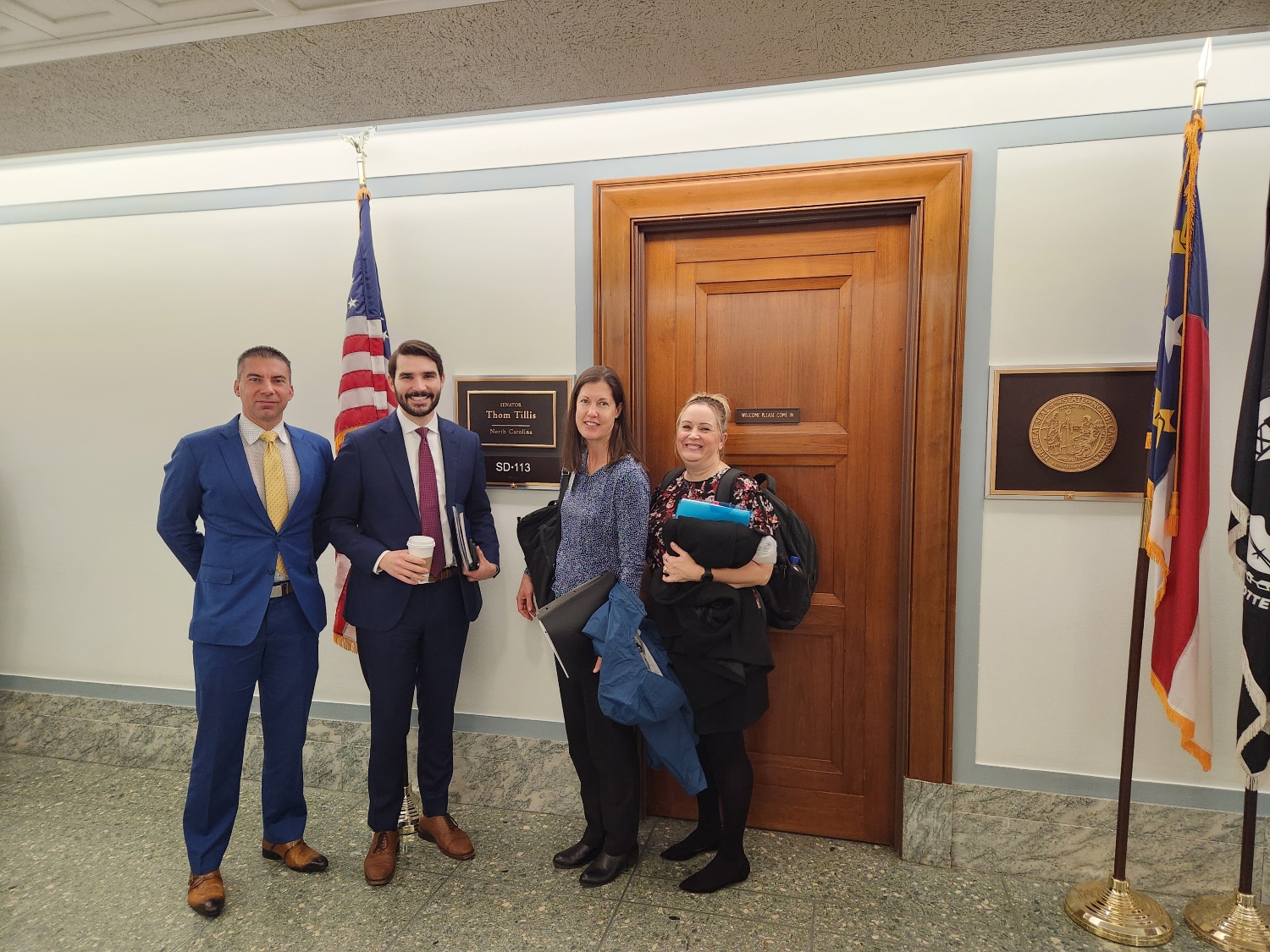
Each year, the AACVPR’s legislative priorities are different, but the goal is the same. “We want to help the legislators see things from the patient perspective and put a face to the people these bills are affecting,” Stacey said. “From that angle, you see the increase in a patient’s quality of life. From a health system perspective, it decreases the rates of hospital readmission. It’s a win-win.”
This year’s priorities centered on two bills: HR-955/S.1849, the Sustaining Outpatient Services Act, and HR-1406/S.3021, the Sustainable Cardiopulmonary Rehabilitation Services in the Home Act. The Sustaining Outpatient Services Act seeks to correct a legislative error from a previous bill that reduces reimbursement for cardiac and pulmonary rehabilitation services when they are provided in off-hospital campus clinics. The reduced reimbursement rate makes cardiac and pulmonary rehabilitation services financially unsustainable and thus eliminates patient access to these resources, especially in rural communities. “Some rural hospitals, which don’t have a lot of real estate on campus, haven’t even tried to open a rehab clinic because of this issue,” Stacey said. This bill would establish an exemption status to certain hospital outpatient services, including cardiac and pulmonary rehabilitation, from that fee reduction.
The Sustainable Cardiopulmonary Rehabilitation Services in the Home Act would allow Medicare beneficiaries to receive cardiac or pulmonary rehabilitation services through real-time telehealth in their homes. This hybrid type of service was very successful during the pandemic, and it allowed more patients to be treated from across eastern North Carolina.
“Think of that 45-year-old patient who had a heart attack and would benefit from rehab services but has also been cleared to work and needs to make an income,” Stacey explained. “This bill would allow that patient to not have to make a choice between income and health; they could do both.”
During her time in Washington, D.C., Stacey and 74 other AACVPR members spoke with their respective House Representatives and Senators to advocate for these bills. Stacey said overall, the discussions were productive.
“I had some good conversations about both bills,” she said. “The telehealth bill was one the legislators could wrap their heads around easier; it was something they were familiar with. That was encouraging.” While more work needs to be done to increase support for the outpatient services bill, Stacey said she felt the needle moved a bit. “This is partly because the government seems to be changing their focus from thinking about the up-front costs of health care to the savings incurred on the back end,” Stacey said. “That means things are changing, and I’m hoping we’ll get a few more co-signatures on that bill.”
As a board member, Stacey said she now has other opportunities to support her profession.
“To represent eastern North Carolina and discuss at the national level some of the things that impact those who practice locally is really important,” she said. Because she was on the board this year, Stacey was also able join the board meeting the day before Day on the Hill and participate in the selection of a new legislative firm. “We met with the firm and prepped for Day on the Hill, but we also strategically planned for the future,” Stacey said. “It was exciting to be involved in that process.”
Stacey’s interest in running for the AACVPR’s treasurer position stemmed from her desire to stay involved in the national organization and escalating care for patients.
“The board is involved in regulatory and government relations, and that’s one of my big interests. Day on the Hill is just one way we stay involved. It’s a way of understanding and supporting initiatives and bringing that back to ECU Health,” she said. “We have six cardiac and pulmonary rehab programs within ECU Health, and I want to make sure those programs are aware of the initiatives the AACVPR promotes to escalate their practice and ensure we’re doing the best we can for our patients.”
Now that the initial conversations with Congress members are over, the next step is to follow up in a few weeks with those representatives still on the fence. “We’ll also bring in a constituent from that person’s district to speak to the impact of these bills,” Stacey said. Some representatives have already signed on to at least one of the bills, including Rep. Don Davis, Rep. Deborah Ross, Rep. Greg Murphy, Rep. Wiley Nickel and Rep. Jeff Jackson.

It’s important to be involved in the policy issues surrounding health care, Stacey said. “You don’t go into health care thinking about these operational or political issues, but when you’re faced with the repercussions in the clinic, you see the impact it has.”
She encouraged all health care professionals to get involved: “Let’s do this for the betterment of the patient experience,” she said. “For me, this has been one of the highlights of my professional life.”
Tanya Graham, a North Carolina native and Greenville resident, was outside cutting her grass when she started to feel very tired. That night, she experienced what felt like an asthma attack, so the next day she visited an urgent care clinic. “I do have asthma,” Graham shared, “but I’ve never had an attack.” The doctor ran a few more tests, and after an EKG, he decided to send Graham to the hospital.
“The cardiologist at [ECU Health] Medical Center said, ‘You are in heart failure,'” Graham said. “I didn’t know what he was saying, I was so shocked.”
Dr. W. Douglas Boyd, a cardiothoracic surgeon, told Graham she needed surgery, and two weeks later, Graham found herself back in the hospital recovering from a double coronary bypass. She was told later that her initial ejection fraction, which is the amount of blood your heart pumps each time it beats, had been 10 percent. A normal ejection fraction is 50 percent or higher. “After the surgery, they did another echocardiogram, and now it’s up to 35 percent,” Graham said.
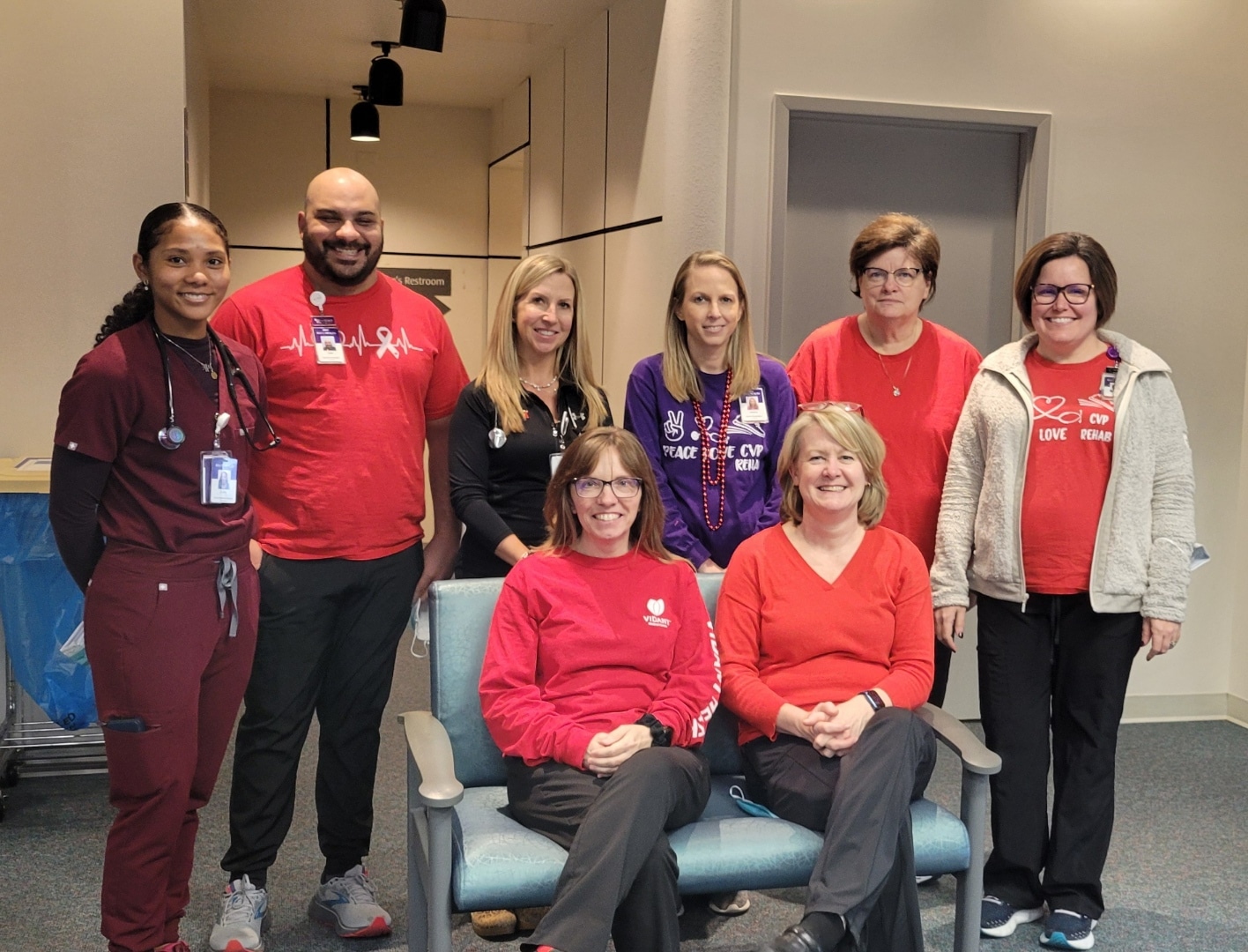
Graham knew that once she was strong enough after the surgery, she wanted to participate in cardiac rehabilitation. She had heard about the option from her neighbor, who also had recently suffered a heart attack. “I also have two sisters who are nurses,” Graham shared. “One of them works for a cardiologist, so I talked with her about cardiac rehab, and all of my siblings agreed it was a good idea.”
Cardiac rehabilitation focuses on the “what now” after a cardiac event. Stacey Greenway, the director for cardiovascular disease management services at the Medical Center, hopes that cardiac rehab will become the immediate program associated with cardiac recovery.
“A multidisciplinary team works with the patients to establish and achieve goals to improve their health, quality of life and functional ability,” Greenway said. “We develop individualized treatment plans for each patient that includes exercise, nutrition, medications, stress management and other components.”
For Graham, therapy started slow, but she said she immediately felt comfortable. “The team is so smart, and they are in tune with each individual person,” Graham said. “It made a huge difference because I learned right off that I could trust them. It made me want to go.”
It also helped to have others around her going through the same experience. “It didn’t matter if they were a man or woman or what race they were – we were all there for the same reason. Our bodies had broken in some way, and we were all there together for the same purpose of trying to survive and extend our lives,” Graham said. “I drew strength from them, because when I saw them working hard, it made me want to do the same.”
The experience didn’t just provide Graham with the chance to get stronger after a major surgery. “The one thing I came away with,” Graham said, “is hope. Hope that I’d live a longer life.” Graham said that it wasn’t just the exercise that encouraged her and helped her get better; it was also the classes they offered. “I learned quite a bit from the classes, which covered things like diet and coping with this diagnosis,” she said. Something Graham didn’t expect was having access to support from a therapist. “I’d had a hard experience with my surgery, so they put me in contact with Dr. Kari Kirian, and she worked wonders. I can’t say enough positive things about that experience.” Dr. Kirian is a cardiac psychologist embedded in the heart failure program – a critical member of the care team as it is not uncommon for patients to experience anxiety or depression after a cardiac event.
While she wished she could have participated for longer, Graham graduated from cardiac rehab with the ability to do the things she needs to do. “It allowed me to come home and do the things you take for granted, like clean the house or roll your hair,” Graham said. She also immediately joined a gym and signed up for personal training to continue her progress. “I left cardiac rehab on a Friday, and that following Monday I was at the gym,” Graham said. “It wasn’t mandated, but the cardiac rehab team provided me with information. My sister goes to a gym, so I decided to go there, and now I go every weekday. I will continue to exercise, think positive and eat right.”
Because she’s feeling so much better, Graham said she has plans for the future. “I’m going to work on making one of my bedrooms a storage space, and in the spring, I plan to paint a shed in the back yard,” Graham said. She also hopes to visit her daughter and grandchildren in Phoenix, Arizona next winter. In the meantime, Graham said she’s cleared it with her doctors to serve as a volunteer in the cardiac rehab unit. It’s one way she can share her experience and give back to the amazing Cardiac Rehab team for impacting her life in an incredible way.
“I don’t care what I do. I just didn’t want to leave there,” Graham said. “I love people, and I thought maybe if I was around people going through what I went through, I could tell them my story and help them.”
Stay on ECU Health’s rehabilitation unit inspires Kasey Shue to pursue recreational therapist degree
To be a health care provider is to answer a calling. For some, the journey to health care is a straight line; for others, the road is winding. This series features stories from ECU Health team members who took the winding road, but found the destination to be worth the effort.
Kasey Shue, a recreational therapist, had no idea that a fulfilling career in health care was awaiting her when she got sick nearly eight years ago.
“I had an undergraduate degree in public relations and communications from East Carolina University,” Shue said. “I worked for the American Red Cross educating people about and coordinating blood drives. Then I went to the hospital with Guillain-Barre syndrome.”
Guillain-Barre is a condition in which a person’s immune system attacks the peripheral nerves, and it can result in near-total paralysis and breathing problems in the most severe cases. Shue’s case was, she said, pretty severe.
“I needed help with everything: I had to learn how to chew, swallow, sit, stand and walk again. It was like being a toddler.” Even more than the physical stress, Shue said that the emotional burden of being in the hospital was trying. “I had a husband and two small children at home,” Shue said. “We actually held my son’s second birthday party in rehab while I was there. It was difficult being away from my family and coming to grips with not being able to do the most simple of things.”
Shue spent two and a half months at ECU Health Medical Center, six weeks of those being on the rehabilitation unit. During her stay, Shue said all therapies were instrumental in her recovery, but recreational therapy (RT) made the biggest impact.
“I didn’t know what RT was before I was in the hospital,” Shue said. “RT affected me the most because it helps people keep being who they are despite their physical barriers. RT helped me schedule my son’s birthday party, and they took me on an outing to Target.” During her stay, Shue said she had a literal epiphany: “It hit me – I was going through this so I could go back to school to be an RT and give back. I wanted to pay it forward.”
After her recovery, Shue went back to school and graduated with her master’s degree in recreational therapy from East Carolina University. She also added an aquatic therapy certification to her degree because of her own personal experience in the therapy pool.
“Aquatic therapy was extremely beneficial to my recovery, so when I went back to ECU I was determined to get that certification,” Shue said.
Shue also knew she wanted to work in inpatient rehabilitation because, “you see people get better in a short time frame, and I like seeing that progress.” She didn’t know, however, that she’d end up working for ECU Health in the same rehabilitation unit where she recovered just a few years prior. “I had no idea I’d end up back here in the Medical Center, but in a lot of ways, it’s my perfect job to come back and help people in the same facility where I received help.”
Shue attributed her success both to the skills she learned in her previous career and the experiences she had as a patient.
“From my work with the Red Cross, I was already familiar with this hospital, as well as general health and wellness education. I also know how to work with people – not everyone does that well.” Shue said her time in the hospital gave her a unique perspective that allows her to be more empathetic with her patients. “I can relate to patients on a different level because I’ve been the one in the bed not wanting to get up or feeling like I couldn’t do the work. I have a rapport with patients and help them work through their pain. It’s made me successful in the patient care side of things.”
That professional perspective also bleeds into her personal life. “I tell people that now I’m Kasey version 2.0,” Shue laughed. “After being sick, I don’t take things for granted. I have more empathy for people, and the smaller things don’t stress me out like they used to.”
Shue said it’s an honor to work with the rehabilitation team, some of whom were there when she was a patient.
“A lot of my primary therapists when I was sick have moved on to other roles, but we still pass each other in the halls and have that relationship,” Shue said. “And some of my former therapists work with me every day. I have a professional respect for them, but we also have a deeper bond because they watched me and helped me get better.”
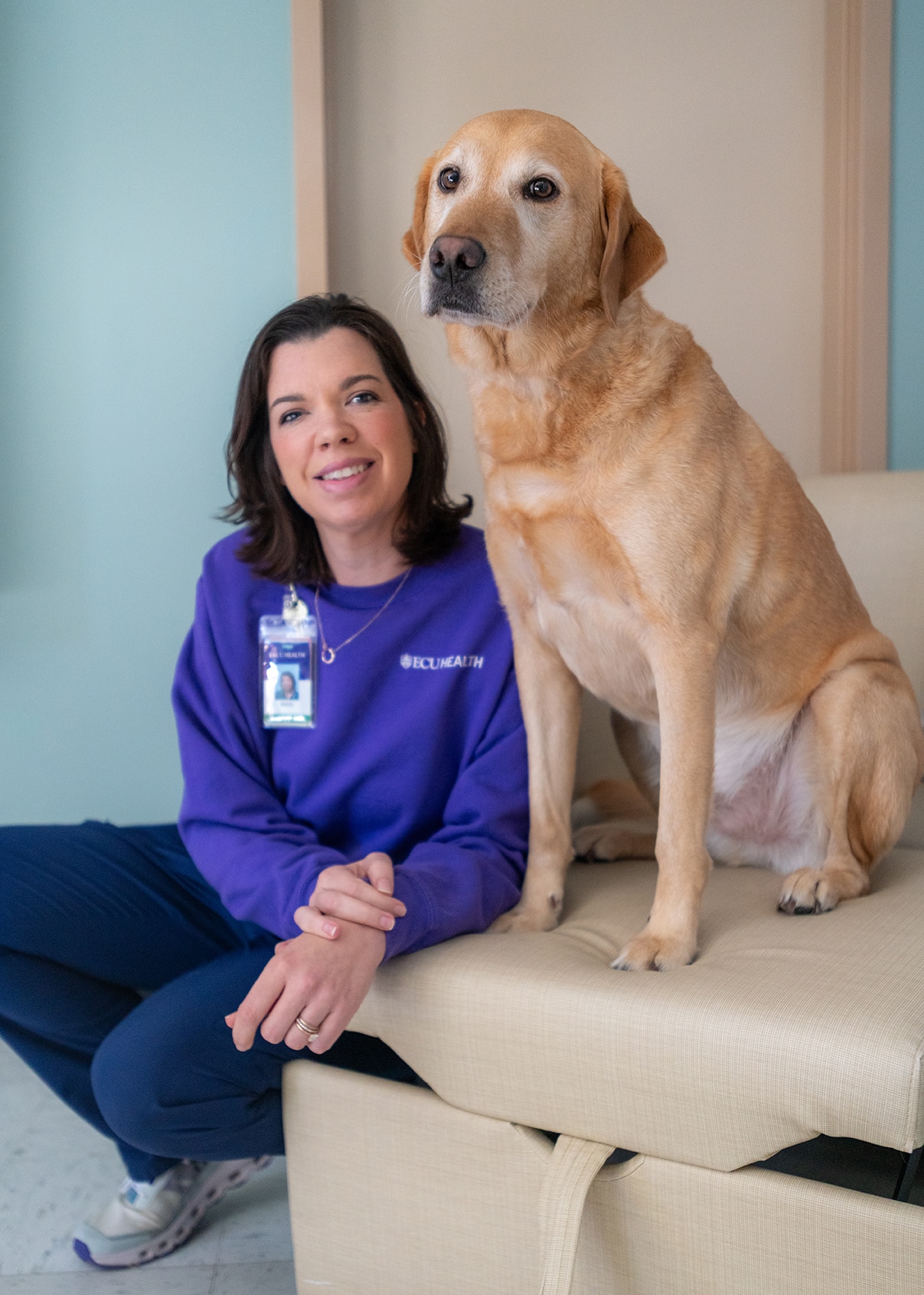
Working beside the people who helped her and providing services to people who are in the situation she was in eight years ago is gratifying.
“I really enjoy what I do, and it doesn’t feel like work. I tell people that I get paid to play.” Shue is also the handler for Clive, a dog who is a part of the Animal Assisted Therapy program and who helps patients in the rehabilitation unit a few days a week. “I’ve always been a dog lover, and as a patient I had several dogs that visited me. I knew pet therapy fell under the RT umbrella; the pieces came together so we could have Clive come in and work with our patients.”
Shue said these professional experiences fill her cup in a way her previous career did not, and her advice for anyone considering a career change to health care is to listen to their instincts.
“Life challenges, whether professional or personal, happen, and sometimes it requires you putting yourself out there and stretching your comfort zone,” Shue said. “If something draws you, listen to that pull. I’m a big believer that things work together for the good, even if you can’t see it initially. I didn’t ask to be sick, but it impacted my entire future in a positive way. Now I feel like I’m right where I’m supposed to be, doing what I’m supposed to do.”
Resources
Greenville, N.C. – ECU Health and the Brody School of Medicine at East Carolina University’s Lora Joyner was recently selected as the National Bleeding Disorders Foundation (NBDF) Physical Therapist of the Year. Each year, NBDF honors those who have made significant contributions to the inheritable blood and bleeding disorders community at its annual Awards of Excellence program.
“It is an honor to be recognized for my life’s work as a physical therapist in the bleeding disorder community by fellow therapists, health care professionals, patients, families, and HTC colleagues,” said Lora Joyner, MS, PT, PCS, physical therapist and clinic manager at ECU Health Hemophilia Treatment Center (HTC). “I am grateful that my name will be associated with Donna Boone and previous award winners and recognized as a role model and mentor for current and future health care professionals in the bleeding disorder community.”
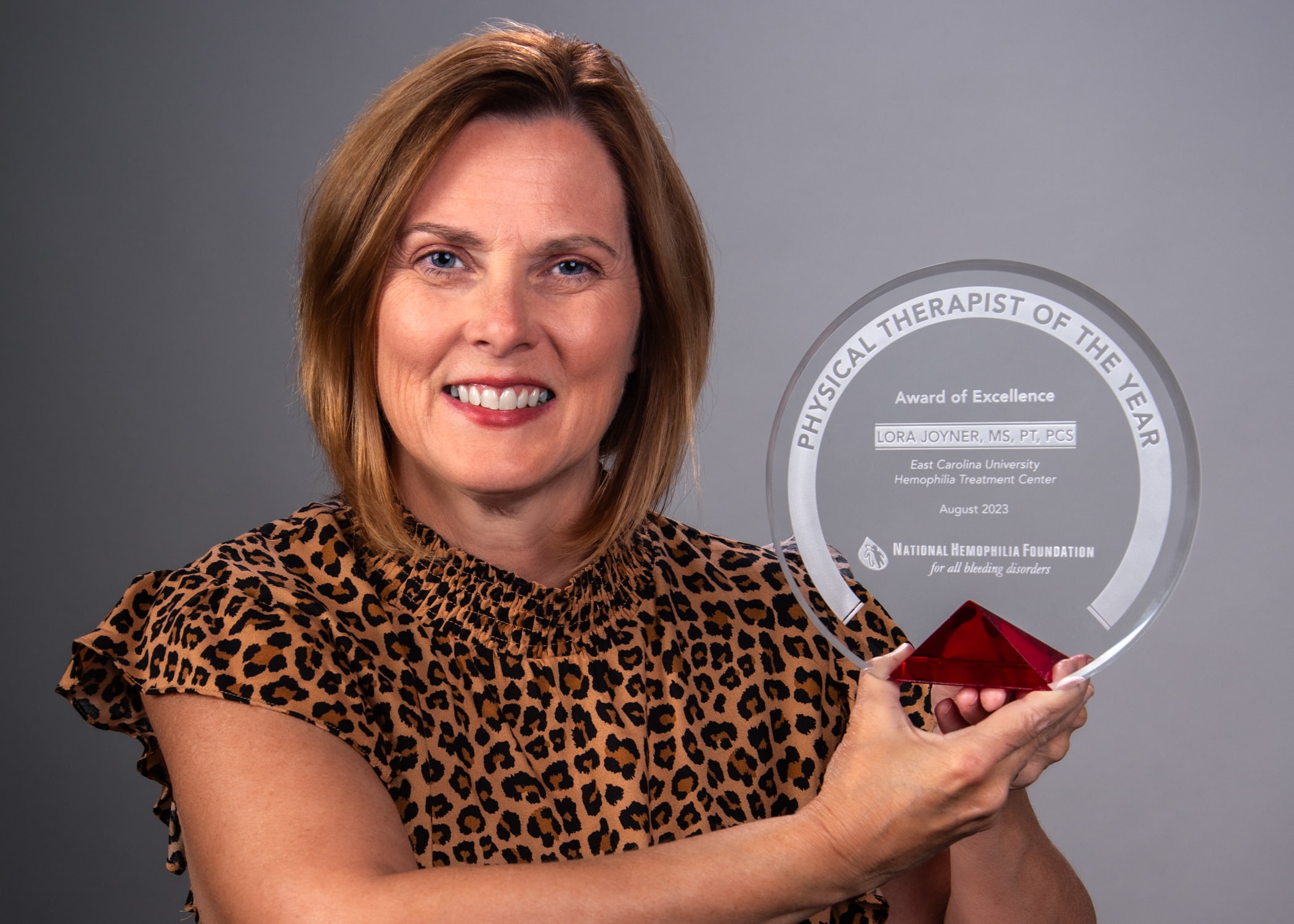
Physical Therapist of the Year, given in honor of Donna Boone, PT, honors an individual who has demonstrated service to the inheritable blood and bleeding disorders community above and beyond their daily responsibilities in an HTC PT role. This person serves as a role model for others in the physical therapy field and has a minimum of two years’ experience working with individuals with blood or bleeding disorders at an HTC. Donna Boone was a pioneer in physical therapy and bleeding disorders and served as a mentor for many professionals.
“We are proud of Lora for all of the hard work, dedication, and leadership she has put into this clinic and into our patients,” said Dr. Beng Fuh, director of pediatric hematology and oncology, “Bleeding disorders, sickle cell disease and cancer are life-changing diagnoses for patients and their families. Lora is an invaluable asset and works hard to ensure patients can live their best lives as possible after diagnosis. Lora’s passion for her patients is reflected by this well-earned achievement.”
Joyner has worked at ECU Health HTC for 32 years as a physical therapist and as the clinic manager for seven years. As HTC manager, Joyner is responsible for selecting patients for clinical trials and research, supporting transition needs of the clinic, quality improvement and writing grants and reports. As a physical therapist, Joyner is responsible for treating any muscular skeletal complications, most commonly joint or muscle bleeds. If left untreated long enough, joint/muscle bleeds can cause chronic pain, long-term joint problems and limited mobility. Joyner also facilitates safe participation in sports and physical activity of patients, including medication management, which allows patients to live an active and fulfilling life. Additionally, Lora has held leadership roles in multiple regional and national organizations. She is the currently the national chair of the physical therapy committee of the NBDF.
“When you see the joy on the face of a little one when you say ‘yes you can play baseball’ after their diagnosis, after they’ve thought they wouldn’t be able to do normal activities, that’s one of my favorite parts of my day,” Joyner said. “All parents dream that their children are able to do normal things, and I’m able to help children do that.”
ECU Health HTC is a nationally recognized comprehensive lifespan clinic with both adult and pediatric specialty services that is one of only three in North Carolina and is part of a national network of over 140 Comprehensive Hemophilia Diagnostic and Treatment Centers, which provide comprehensive specialty care to people with rare inherited bleeding disorders and their families.
For the second year, Susan Callis, recreational therapist with ECU Health, volunteered her time to serve as a swim partner in The Crossing on Aug. 12.
The one-mile event is held annually at Lake Gaston, and participants can swim, float, paddle or walk the distance to raise funds that support the Lake Gaston community.
Last year, Callis worked with Brent Carpenter, a former ECU Health outpatient, to help him swim the distance.
“It was his idea,” Callis said of participating in the swim event. “He grew up around Lake Gaston and knew about the event.”
Carpenter sustained a spinal cord injury 17 years ago after diving into a swimming pool, but Callis became more acquainted with him while he was participating in outpatient aquatic therapy after he broke his femur while water skiing.
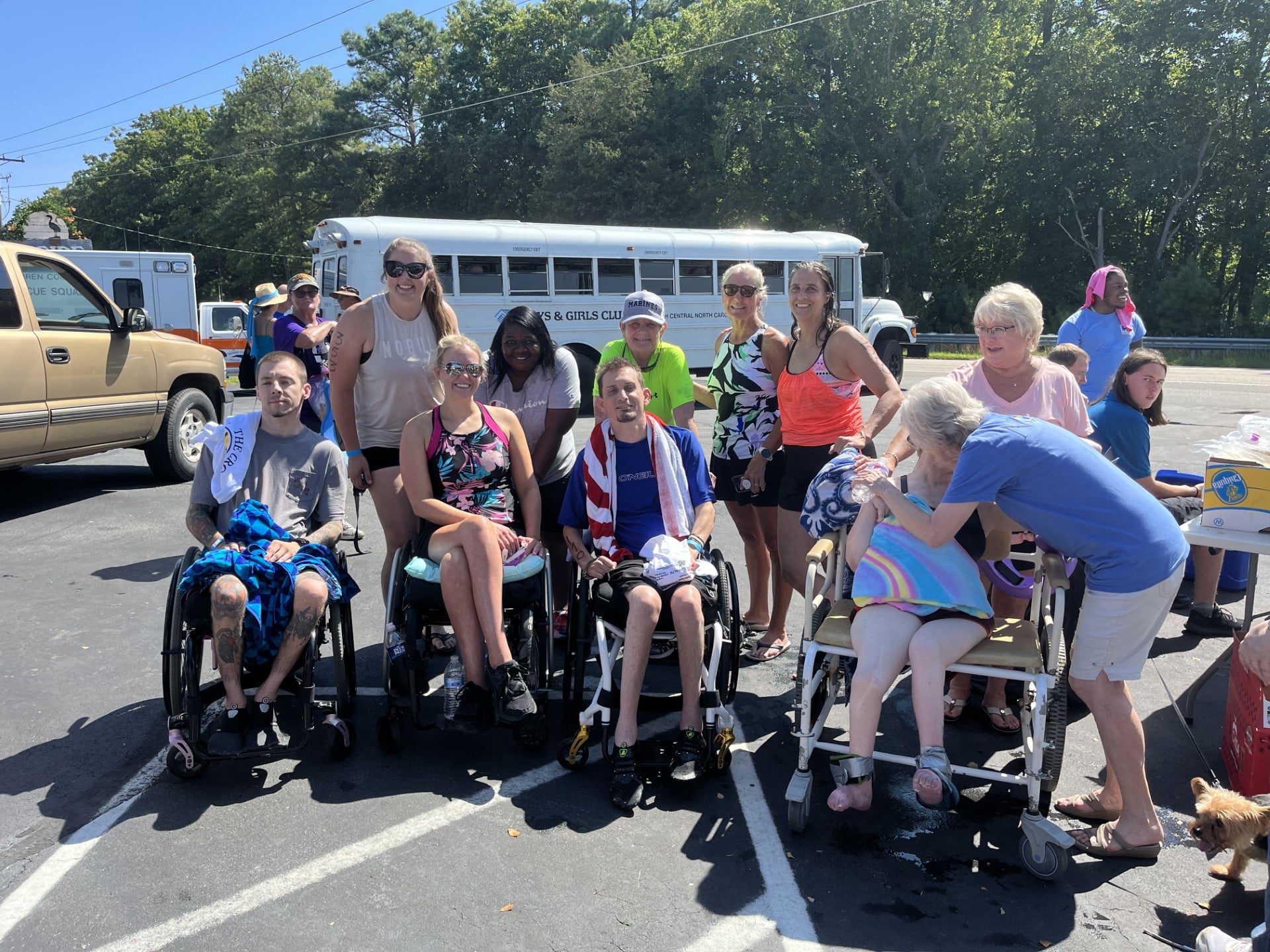
“I had observed him in outpatient therapy working on swimming and water safety skills to gain more strength and endurance,” Callis explained. After Carpenter was discharged from outpatient therapy, he continued to use the therapy pool and work with Callis to practice because he wanted to complete an open water swim. “This wasn’t a part of his therapy,” Callis said. “It was a personal goal, so I agreed to help him train to meet that goal. I wasn’t on the clock, but I chose to volunteer.”
Callis said her interest in aquatic therapy began after graduating from East Carolina University with a degree in recreational therapy, but she always loved the water.
“I grew up with a pool. I’m a water person. Most of my vacations are around the water,” Callis said.
During her first job after college, Callis took senior citizens to the local YMCA pool for exercise.
“I was not formally trained,” she admitted. “But I saw how free and happy the people were in the water and how they moved easier. I thought, ‘this is awesome.'”
From there, Callis found out about a water therapy conference in Washington, D.C. and her supervisor gave her the time off to attend. It was then she realized this was what she wanted to do. That confidence in her newfound passion led her to a job with ECU Health.
“I had a job but was looking to move back to Greenville,” Callis said. “I knew the hospital was building a pool facility and I asked the manager of the recreational therapy department what I needed to do to be eligible to apply for a job with them. He told me, and I went home and worked on those things. When it came time to apply for the job, I got it and I’ve been here ever since.”
That was in 1997, and Callis has been an essential player in ECU Health’s aquatic therapy.
“It was the right fit. I coordinate the aquatic therapy program and we’re fortunate to serve through the entire continuum of care, from acute to outpatient and community-based services,” Callis explained.
While she wasn’t initially looking to serve as an able-bodied swim partner in The Crossing, Callis said it’s been a good change of pace to her daily routine. This year, Callis agreed to be the able-bodied swim partner for an adult woman with cerebral palsy.
“Training her has challenged my problem-solving skills to help her be as independent as possible while improving her endurance,” Callis said. “When working with individuals with physical disabilities, the swim strokes are similar, but you have to adapt them to the diagnosis and the individual’s needs. I’ve had to figure out the logistics of things like getting my swim partner in and out of the lake, moving wheelchairs and coordinating volunteers. It’s fun because I’m training too!”
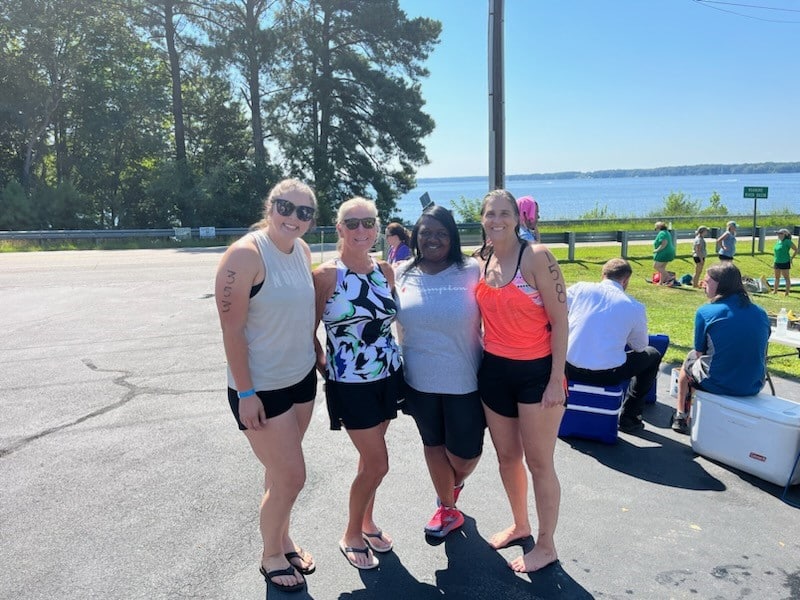
After last year’s success, this year, Callis helped coordinate five swimmers with physical disabilities to complete the event.
“With five swimmers, I needed help,” Callis said. She reached out to her team, and several were eager to help.
Kristin Jones, recreational therapist, Tasha Williams, clinical nurse specialist and Karen Pickles, physical therapist, also volunteered their time to help train and support the swimmers.
“Kristin and Karen were in the water to support the swimmers by paddle board and kayak, in addition to me,” Callis shared. “Tasha offered help with wheelchairs and transfers and cheered us on as we swam.”
That team support means a lot, but Callis said it’s not surprising that her colleagues jumped in to help.
“All of these swimmers except one have been our patients in some capacity over the years,” Callis explained. “It’s fulfilling to see a patient go from a new injury, when they’re at their most vulnerable, to having goals and flourishing. It’s nice to see it come full circle. These were once our patients, and now they’re our peers in the community.”
Callis added that while it’s rewarding the see a former patient thrive, she knows the value of them setting their own goals and putting in the work to reach them.
“The swimmers do this not because it was prescribed, but because it’s what they want to do,” she said.
Speaking about The Crossing after the event was completed, Callis said it was a huge success.
“All five swimmers completed their one-mile swim, and they were greeted on the other side by friends, family and their ECU Health family,” Callis said.
The date for next year’s event is already set, and Callis said that while she wants to help coordinate, she mostly wants to swim the one mile herself alongside the swimmers she’s helped train. In the meantime, Callis has other plans. Her next project is partnering with the city of Greenville to offer adaptive kayaking clinics. Whatever she does in the future, Callis said the work she’s done to support swimmers has been invaluable.
“It makes me happy,” she said. “It gives me such satisfaction, and reminds me that this is why I do what I do.”
It’s been sixteen years since Brent Carpenter’s life-changing injury.
“I dove into the pool with a shallow dive, hit the front of my head, and that knocked me out completely,” Carpenter said. “And I woke up on the surface where I couldn’t move any extremities.”
Paralyzed by the accident, the eastern North Carolina resident never gave up.
“The smallest little things can help you tremendously. So I have a saying that small steps are monumental gains,” Carpenter said.
Those small steps have served him well. Brent has since regained partial function of his hands and arms. He’s also tackled a massive personal goal, completing an annual charity event called “The Crossing” that takes place at Lake Gaston.
“The idea is that you’re crossing this part of the lake, which is give or take a mile, and however you want to – you can swim, you can kayak, you can float, paddle board, however you can get across,” Carpenter’s trainer, Susan Callis, said.
“A lot of people thought, ‘You are swimming this with a life-jacket, right?’ I was like, ‘Absolutely not.’ I wanted to do this just like everybody else was doing this and show people that anything’s possible,” Carpenter said.
Brent’s mindset and persistence served him well.
“We started out working on pool entry and exit,” said Callis, “and then working on water safety skills, working on breath control and lap swimming, holding his breath underwater.”
“It started as a half mile”, said Carpenter, “then I got three quarters there and then I got to the point where I was doing it consecutively during the week”.
It’s evidence-in-action that anything is possible with commitment, dedication and no shortage of cheerleaders.
“You do whatever you can to get across, first of all”, said Carpenter. “But I have always swam on my back when it comes to long distances. So when I came up to the finish line, I couldn’t see, you know, I didn’t have eyes in the back of my head. But when I turned around and Susan was right beside me like, you know, I heard the biggest applause I’ve had since playing sports when I was walking. To achieve a goal like that is, it’s priceless”.
It’s one impressive goal down with many more to follow.
“I think my goal each year is to make the world more accessible”, said Carpenter, “to not only my friends, but just people in my community that’s going through the struggle like me.”
Resources
Meet Clive, ECU Health Medical Center‘s resident canine.
“Currently, he’s working two days a week with us,” said recreational therapist and dog handler Kasey Shue. “Some mornings when we go through the hospital doors, he’s just like, on a mission. I have to be like, ‘Clive, wait, hold on, buddy. You’re like, ready to roll this morning’. So I think he knows what he’s here to do.”
It’s an assignment he’s well prepared to tackle.
“A service dog is specifically trained to do certain tasks for somebody with a disability,” said Clive’s owner and outpatient rehab supervisor Tanya Bowen. “So a therapy dog is basically to provide comfort and they have to be very friendly and outgoing because there’s a lot of people that want to pet them and touch them. They have to be calm. They have to like the interaction, the social interaction. So he’s kind of like a little combination of both.”
Clive’s skill set benefits patients in a number of ways, whether that’s assisting with physical needs or providing emotional support.
“We’ll partner up with a physical therapist or an occupational therapist and we’ll work on walking him if they’re working on mobility improvement,” Shue said. “We’ll work on throwing a ball if they need some hand strengthener. We’ll work on them being able to pick up a very small treat and hand it to him if they have fine motor limitations. We really try to incorporate him into whatever functional skills they are trying to learn to make their life easier when they get home. On the other side, many times we have patients that are depressed or anxious. They don’t like being in the hospital and he just provides that comfort.”
And his services are in demand at the bedside and beyond.
“He actually wears a vest that says, I’m friendly, please ask to pet me,” Shue said. “We absolutely encourage that because he is therapy for our patients, but he’s also therapy for the staff, the families.”
Resources
ECU Health Therapy & Rehabilitation
Watch more ECU Health News videos
At ECU Health, team members go above and beyond to form trusting relationships with patients and their families to better serve eastern North Carolina.
Over the last 14 years, Occupational Therapy Assistant Winnie Miller worked one on one nearly every week with Taylor Anthony, who is now preparing for his freshman year at the University of North Carolina Wilmington. Taylor is autistic and began receiving treatment from an occupational therapist when he was 3 years old.
First steps
Kim Anthony, Taylor’s mother, recalled the early days of her son working with an occupational therapist.
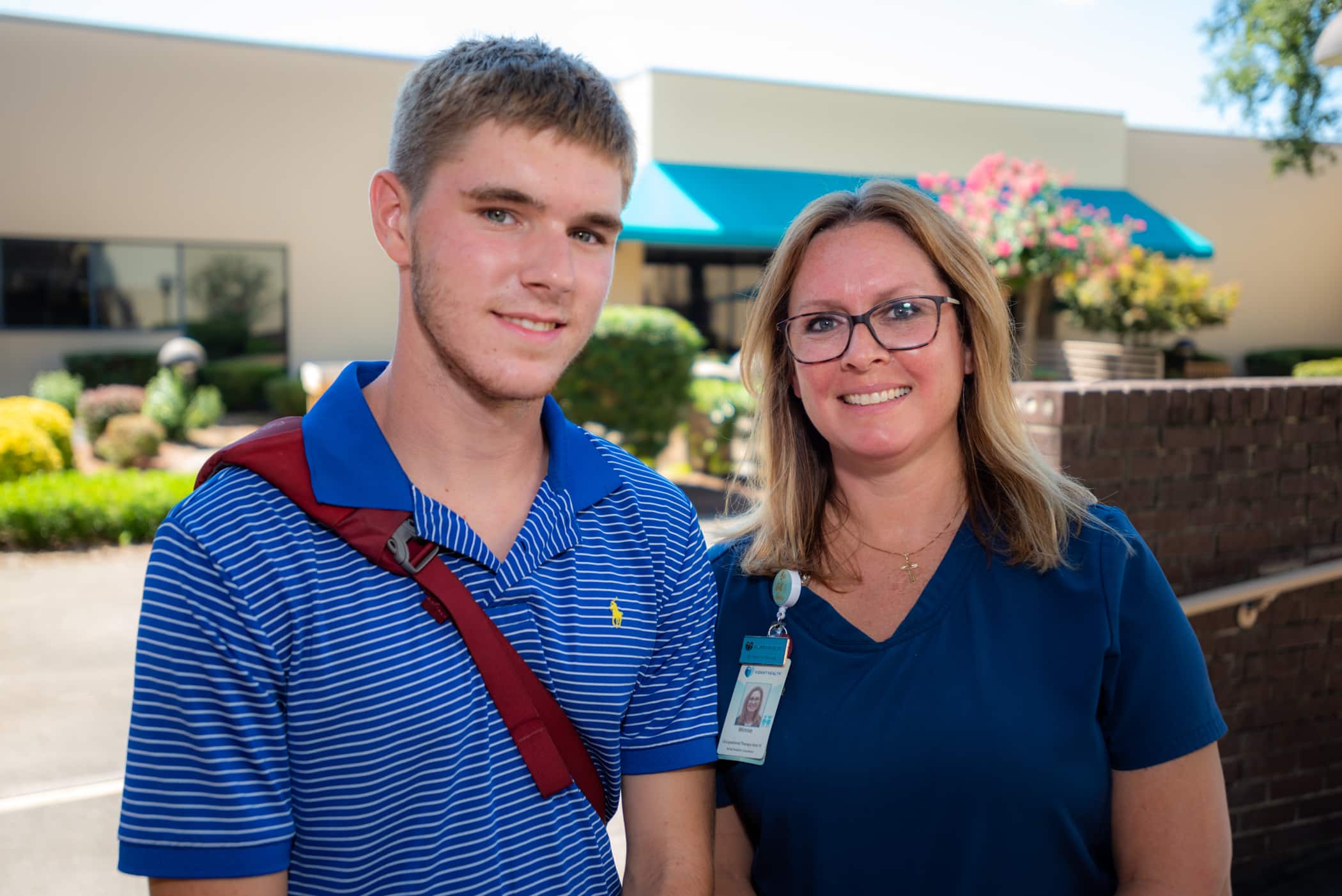
“He was my first child and had special needs,” Kim said. “I remember walking in and just being terrified – you don’t know what your future looks like, or his future, or will college even be an option.”
After about a year of working with a couple of other occupational therapists within the health system, Miller stepped in and began her treatment sessions with Taylor.
Miller said their work together started with the base steps – figuring out hand dominance, holding pencils, learning to write, forming letters and coloring within lines.
Kim said as Taylor reached school age, she’d be frustrated when hearing about things that people believed Taylor could not do. But she knew she could turn to Miller and her expertise to come up with a plan to help Taylor reach his goals.
“I would email her and be like, ‘I’m struggling with this’ and she would be like, ‘OK we’ll figure it out,’” Kim said. “She would have checklists for him and just everything. It was amazing. She was the biggest support system I had.”
Hitting their stride
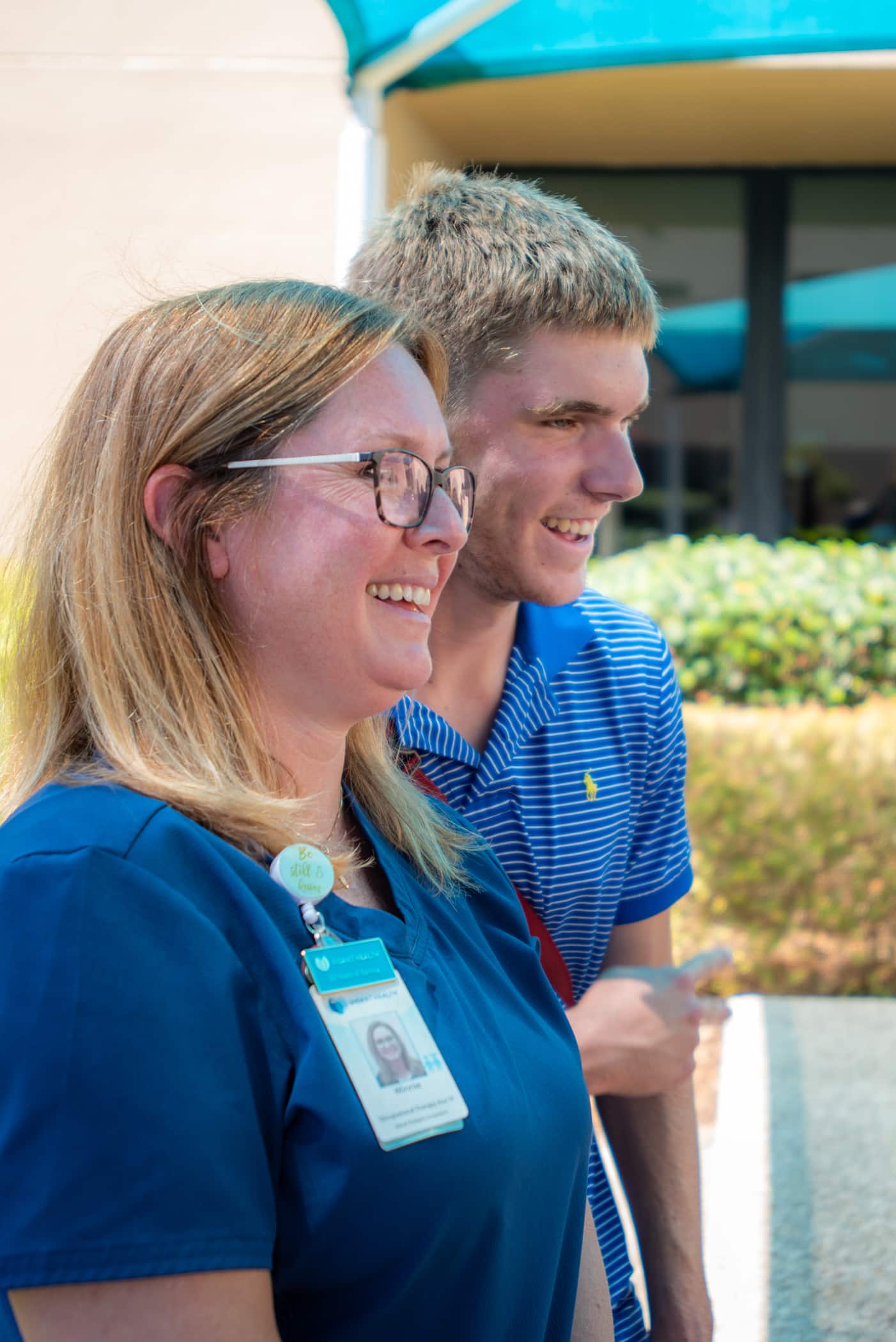
As Taylor got a bit older they worked on how to tie shoes and other fine motor skills. Then it was on to processing your environment and communicating clearly, social aspects of life, how to drive, and other elements of college life and living independently.
Miller compared her role as an occupational therapist to being a coach, with the patient’s supportive family as the team.
“The coach can give suggestions and a play-by-play plan of what you need to work on, but we’re just a little snippet,” Miller said. “I’m only with him an hour a week. They, as a team, have to work on those skills 24/7. I knew they were doing their work at home and there was always going to be follow through.”
Taylor’s father Stephen Anthony, director of service line development for Women’s and Children at ECU Health, said Miller’s out-of-the-box thinking greatly benefited Taylor’s growth into the young man he is today.
Miller broke down the learning process, kept his steps very goal-oriented and stayed in frequent contact with the Anthony family along the way.
“She made it manageable; she made it like they were just going to visit with each other. It wasn’t like a clinical visit, it was just, ‘Hey let’s go in my office and look at some stuff,’” Stephen said. “Maybe they do some stuff on the computer, maybe they use the kitchen to make some eggs or something like that, safety skills with the oven. Stuff that nobody would ever even think of.”
Off and running
These visits also included working with Helen Houston, an occupational therapy driver rehabilitation specialist, who addressed Taylor’s fitness to drive, to ensure he could approach driving safely.
Stephen said Taylor took one test as he was approaching driving age that showed his reactions and reflexes were borderline to be a driver. Before he took a driving test, he was put through the same tests, which showed about 75 percent improvement thanks to his hard work. Now, Stephen said Taylor is just as good a driver as anyone and probably safer than most his age because of the work he’s done.
Taylor said he was thankful for his time with Miller and he’s excited to take all he’s learned to Wilmington.
“It has meant a lot,” Taylor said. “I’ve definitely learned many things. It also took a lot to learn from a different perspective. My family means a lot. They’ve done everything for me to be sure I’ll be the most prepared human being. They’ll know I’ve learned enough to make good decisions and they’ll be supportive of me no matter what.”
As Taylor prepares for his first year of college, one where he’ll also compete as a member of the UNC Wilmington Cross Country team, his family knows he is prepared for different aspects of college life, thanks in part to his work with Miller.
Miller said she loved working with Taylor and can’t wait to visit with him when he returns from school and hear about his college experience.
“He was always an hour a week that I looked forward to,” Miller said. “He always had a new question for me or something new that kept me on my toes and I didn’t know what was going to be the question of the day, what we were going to have to explore and figure out. I really enjoyed that challenge. I’ve loved every minute.”
Resources
Learn more about Therapy & Rehabilitation services at ECU Health.
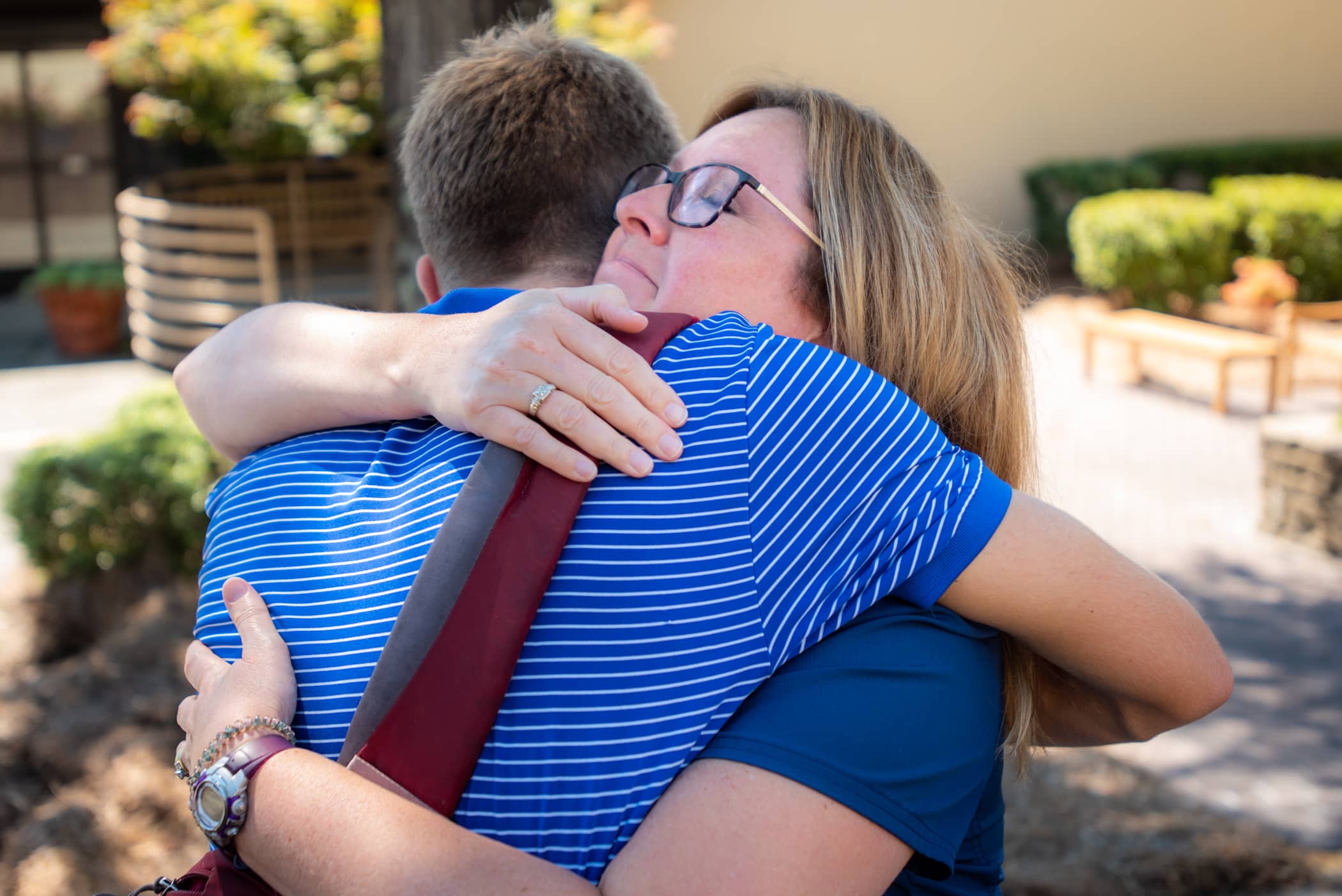
Vidant Health hosted the Run, Walk & Roll to Independence Road Race on Saturday, Oct. 16 to get community members active and raise funds for Vidant’s Therapy and Rehabilitation Services.
Fifty-three runners came out for the event in Greenville and some participated virtually. The road race offered three distances for attendees, including a 100-yard dash for children, a 1-mile fun run and 5K race.
Clint Faulk, medical director for the Vidant Rehabilitation Center, said this is an important event to celebrate the Therapy and Rehabilitation services for the health system.
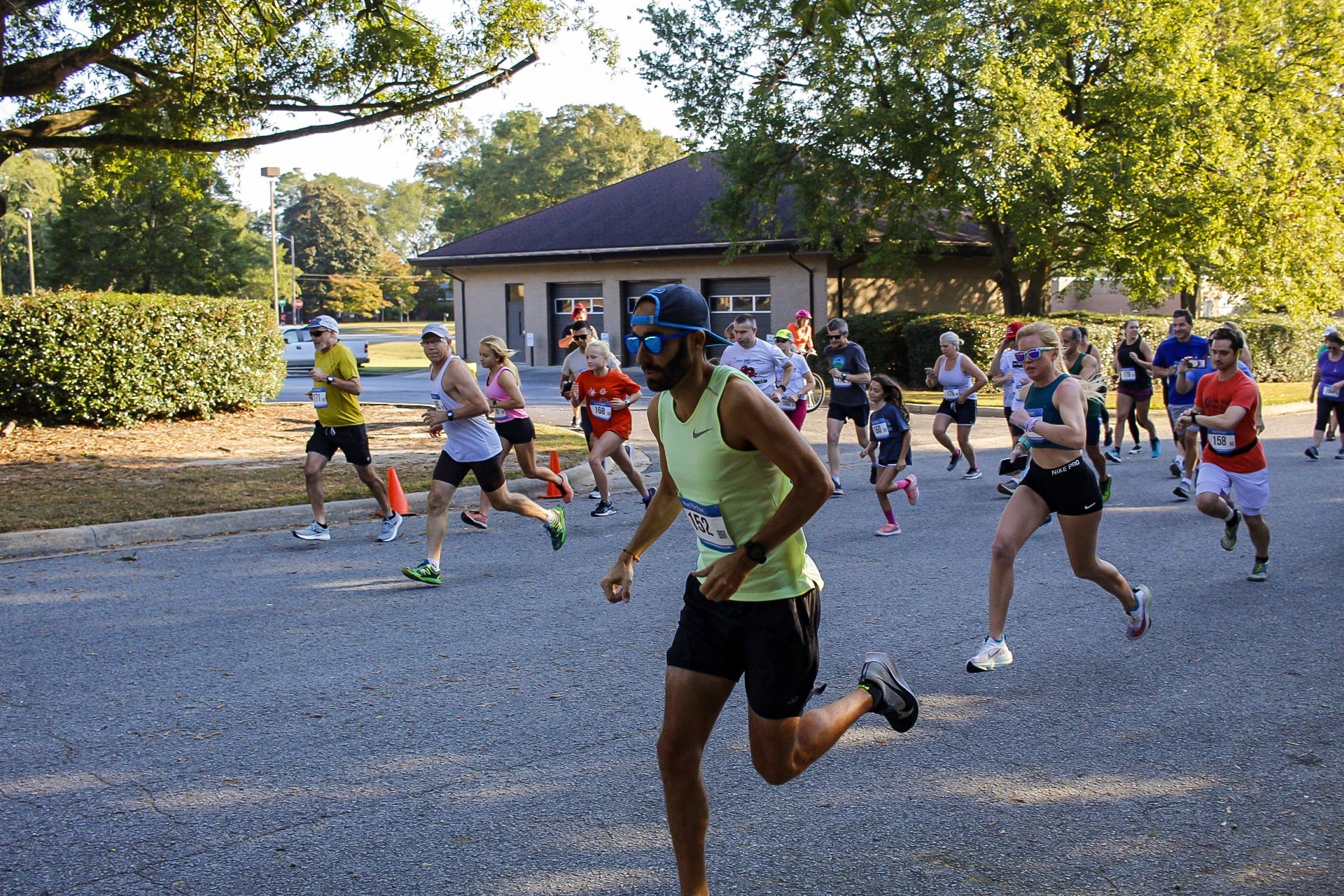
“Rehabilitation services really helps people get home again and get back into the community,” Faulk said. “Patients come in for different diagnoses and they go through therapies with us, three hours of therapy a day. It really is about getting people back home to their families and getting them into their community.”
The event was making its return after two years away; first a hurricane washed out the event in 2019 and the COVID-19 pandemic halted last year’s plans. Kasey Shue is a recreational therapist at Vidant and served as the chairperson for the event. She said she was thankful and excited to be back for this special event.
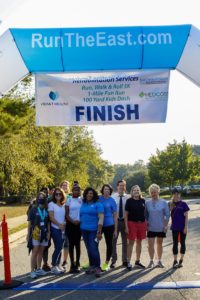 Shue knows firsthand the importance of the rehabilitation services Vidant offers. About five years ago, before becoming a Vidant team member, she was a patient going through rehabilitation for six weeks while recovering from a neurological condition called Guillain-Barré Syndrome.
Shue knows firsthand the importance of the rehabilitation services Vidant offers. About five years ago, before becoming a Vidant team member, she was a patient going through rehabilitation for six weeks while recovering from a neurological condition called Guillain-Barré Syndrome.
“That actually inspired me to go back to school to become a recreational therapist,” Shue said. “I’m just one of the many members of the team that Vidant has on hand to help people live the most functional and active lifestyle they can, regardless of any medical condition, circumstance or disability that they may have.”
She said she was proud to serve as the chairperson for the road race and help organize the event along with Therapy and Rehabilitation Services colleagues.
“It’s just a personal passion of mine and this sort of event that supports rehab and encourages people to get out and continue to be active – even if they do live with some type of limitation or disability – I’m all for supporting that,” Shue said.
Proceeds from the road race benefited Vidant’s Therapy and Rehabilitation Services and in turn help community members in the program.
Visit the Vidant Rehabilitation Center Facebook page for more information and updates.
